| Mervyn Srodzinsky provides a detailed illustrated
history of Stafford Road Locomotive Works from its early
days of locomotive building and maintenance through to
its final closure 115 years later. |
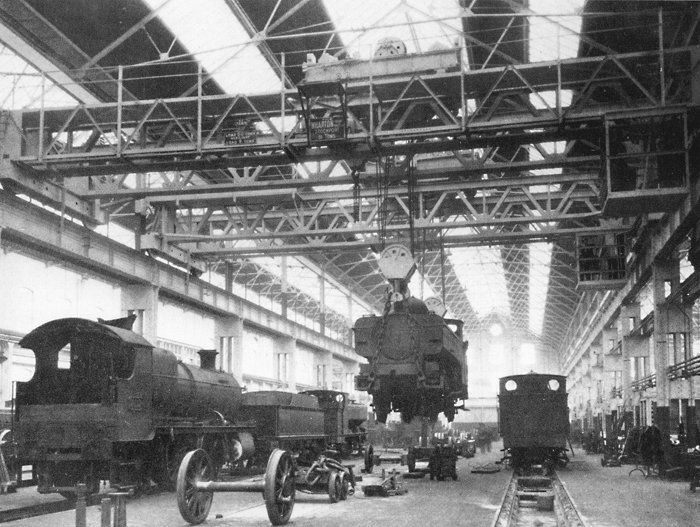
Although the history of Stafford
Road Works can be traced back to the days of the
Shrewsbury & Birmingham Railway in 1849, the evolution
of the site was not really complete until the Great
Western Railway was able to access a Government grant
from 1929, and it is the impressive buildings erected
with these funds that are instantly recalled by most who
visited. The long overdue upgrade for the site
encompassed land to the west side of the Victoria Basin
line south from Stafford Road Junction, the previous
Works buildings being hemmed in between this line, the
LMS route north from Wolverhampton station towards
Bushbury, and the GWR's Birmingham to Shrewsbury route.
This view inside the new Works erecting shop was
photographed in 1933, shortly after its completion.
Taking centre stage, a fifty-ton overhead crane is
lifting an 0-6-0PT from its wheel sets, ready for
overhaul, while a Churchward Mogul is also present, on
the left. Author's Collection. |
|
The history of the development of
the Great Western Railway's Stafford Road Locomotive
Works at Wolverhampton is to some extent quite complex.
In November 1849 the Shrewsbury & Birmingham Railway
(S&BR) decided to establish a small Works premises and
sheds for the stabling and maintenance of its
locomotives and carriage stock alongside the Stafford
Road at Wolverhampton. At this time there was little
capacity for any major locomotive repairs to be
undertaken, and everything, other than small parts, had
to be obtained from the various private manufacturers
that originally built and supplied the locomotives.
Additionally, a goods building and yard were laid out
under the lee of the adjacent Dunstall Hill area.
In 1850 a temporary station was
also built, and which formed a part of the Works
complex, its main function probably being to supply the
Works premises with construction materials, the
station's run-round facilities forming a part of the
Works sidings.
It was in 1853 that Joseph
Armstrong was sent from Chester in order to take charge
of the Works at Wolverhampton. In the following year,
subsequent to the Shrewsbury & Birmingham Railway having
been amalgamated with the GWR, Armstrong was appointed
as Locomotive Superintendent of the then newly-formed
Northern Division of the Great Western Railway. As such
he was given control of all the standard gauge areas of
the GWR from his new headquarters at Wolverhampton.
Initially the only standard gauge sections of line were
over the Shrewsbury route, and over the mixed-gauge
track as far as Birmingham.
In 1854, however, the former
Shrewsbury & Birmingham Railway's Works at Stafford Road
were partly demolished to make way for the GWR
connecting line which linked the station at
Wolverhampton (Low Level) to the line from Shrewsbury at
Stafford Road Junction, so as to create a continuous
route for the increasing standard gauge traffic from the
north down to Birmingham. At around this time the GWR
also transferred its Wolverhampton carriage and wagon
maintenance up to the Works at Saltney, near Chester,
and Wolverhampton took over the locomotive repair work
that had previously been carried out there. |

A track plan of the Shrewsbury &
Birmingham Railway's headquarters at Stafford Road in
1849. The railway, arriving from the right of this map,
crossed Stafford Road to reach a temporary terminus in
Wolverhampton from 12 November 1849, the need for this
effectively being removed thanks to the use of the L&NWR
station from 1 December 1851, the S&BR endeavouring to
forge a good relationship with that concern to access
Birmingham via the Stour Valley line. However, it was
not to be, and the junction to the right of this view
would become Stafford Road Junction in 1854 when the
S&BR threw in its lot with the newly arrived GWR, and
the S&BR siding alignment shown here helped pave the way
for the link to Wolverhampton's new GWR station.
However, the previous S&BR line into Wolverhampton would
long be perpetuated by the Great Western thanks to well
established goods facilities at Victoria Basin that
needed to be served. Author's Collection. |
|
The GWR had established its own
broad gauge locomotive depot on the opposite side of the
Stafford Road to the S&BR complex, but this site lay
physically lower by some thirty feet than that of the
S&BR, a topographical problem that would hamper the
logical enlargement of Stafford Road Works in the years
to come. Separated by the Stafford Road itself, and at
their different levels, the two parts of the future
Works and shed complex became referred to by the GWR as
'High Level' and 'Low Level' or 'Lower Yard', not to be
confused with the subsequent designation as 'High Level'
and 'Low Level' of the respective LMS and GWR railway
stations in the town.
It was in 1858 that a policy of
expanding and re-arranging the Stafford Road Works was
initiated, and the original S&BR buildings were
variously demolished or converted to other uses. Amongst
other changes, the S&BR running shed was replaced by an
erecting shop, and a GWR locomotive shed (believed to be
broad gauge) on the eastern edge of the site, adjacent
to the line from Cannock Road Junction to Stafford Road
Junction, was then converted and extended for use as a
smithy and forge. To the side of the erecting shop was a
wheel shop, and to its south was a traverser, with a
number of parallel roads used for General repairs and
the running maintenance of locomotives. A boiler shop
and foundry were built on the site of the earlier goods
yard. The old repair shop became a machine and fitting
shop, with two pits for the erection of new locomotives.
In due course the first Stafford
Road-built locomotives emerged from the re-organised
Works in September and October 1859, these being two
2-2-2 tender engines, Nos 7 and 8, with 6ft 2in driving
wheels. From this year onwards the standard gauge
locomotives also then began to run south of Birmingham.
To accommodate the increase in traffic a new standard
gauge locomotive shed was erected next to the broad
gauge shed in the lower yard, and this became known as
'Shed No 1'. It was about two feet above the rail level
of the broad gauge shed, and the connection between the
two levels had to be made at some distance.
As from 1860, the GWR's collection
of standard gauge locomotive stock was to be further
increased with the acquisition of some 21 assorted
engines from the newly amalgamated Birkenhead Railway.
At the same time the old Great Western broad gauge
services were being gradually decreased, and the engines
and stock were taken back down south. However, it has to
be kept in mind that broad gauge working around
Wolverhampton did not finally cease until almost the end
of 1869, and until then a contingent of these
locomotives and stock would no doubt also have been
maintained at Stafford Road Works. A book listing rolled
plans which was deposited at the Works makes reference
to either work carried out or details relating to GWR
broad gauge locomotives Salus, Dial la, Peri,
Wolverhampton and Prince for the period 1859 to 1861. As
these plans were kept at Stafford Road Works, and not
Swindon, there is a strong inference that these
locomotives would have been visitors to the Works at
Wolverhampton. It would also be fair to assume that the
engine Wolverhampton would have been maintained at
Stafford Road Works on a regular basis. |

A diagram of the broad gauge
locomotive yard opened to the south side of the Stafford
Road in 1854, on the opposite side of the main road to
the former S&BR narrow (standard) gauge facilities of
1849, and accessed via the new link from Wolverhampton's
GWR station to the newly made Stafford Road Junction.
The 1860 development of a standard gauge shed and other
facilities are also shown. Author's Collection. |
|
Interestingly, it was some
considerable time before all of the broad gauge track
was completely removed from the lower shed yard, and
this rail can still be seen in situ in the foreground of
various photographs taken of locomotives up to 1878,
almost ten years later on, curving away towards the old
broad gauge shed. It is something of a puzzle as to why
this track was retained for such a long time as it was
taking up valuable yard space. The last broad gauge
train working from Wolverhampton is believed to have
been a cattle train, and just possibly with the 0-6-0
locomotive Salus in charge, which may have previously
received attention at Stafford Road Locomotive Works as
late as October 1869, according to an entry given in the
book of rolled plans, but as this date falls between two
entries for 1859, it may be incorrect.
One final link to the old broad
gauge days was however re-established in 1890 when,
following the withdrawal of the broad gauge 2-2-2
locomotive Bulkeley, its boiler was sent up from Swindon
Works to Wolverhampton for stationary use in the Works.
Capacity at the Stafford Road Works had, however, been
put to the test from 1863 onwards as a result of the
influx of yet a further batch of standard gauge
locomotives, which were acquired as a result of the
GWR's amalgamation of the Oxford, Worcester &
Wolverhampton Railway (OW&WR). The old wooden OW&WR
locomotive shed, situated at the Low Level station, was
now vacated, and demolished later on. The engines from
there were also transferred over to Stafford Road,
adding even more to the workload. For some time now it
had been hoped to increase the area of land available by
excavating a sandstone hill which was on the western
side of the Works. Unfortunately this plan could not be
achieved as the landowner refused to sell to the GWR,
and so the Works had to be re-organised (yet again) in
order to make better use of the existing land that was
available. |
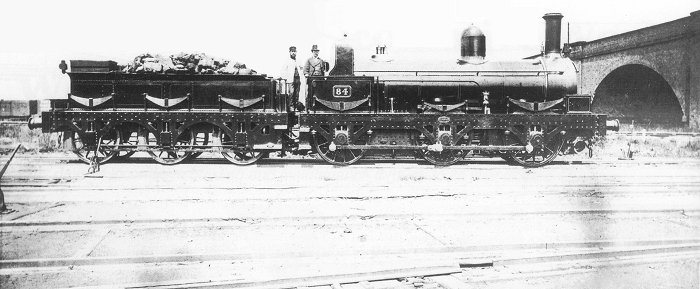
Swindon-built '79' class 0-6-0 No
84 is seen at Wolverhampton subsequent to its extensive
renewal, completed at the Stafford Road Works in
February 1877. Of great interest is the original GWR 7ft
gauge track still in place in the foreground of this
photograph; the broad gauge was officially withdrawn
from Wolverhampton in 1869. However, as No 84 was not
renewed at the Works until 1877, this photograph must
have been taken some eight years later on. The track
appears to be heading in the direction of the old broad
gauge shed in the lower yard, out of view to the left,
so the link from S&B Junction to Stafford Road Junction
is behind the engine as we look north-east, and the
viaduct on the right carries the L&NWR route from
Wolverhampton to and from Stafford. Author's Collection. |
|
The only viable solution that was
available to alleviate this lack of capacity was to
duplicate certain facilities in the lower yard area. New
erecting, fitting, and machine shops, together with a
smithy, were built in between the broad gauge running
shed and the stores. The broad gauge shed itself now
became a tender shop, and it was later partitioned into
both a paint and a tender shop; sheds Nos 2 and 3 were
erected alongside No 1 shed on the broad gauge ground,
creating a vast running shed capable of accommodating
some 120 tender and tank engines. A wide connecting
footbridge was also constructed between the two sections
of the Works, over the Stafford Road itself, thereby
making staff communication between the two respective
sites a much easier task.
By this time the enlarged Northern
Division Works was now the greatest running centre on
the GWR, with the locomotives built there also being
maintained and shedded within the Works complex. The
Wolverhampton Northern Division actually extended as far
as London, Oxford, Worcester, Newport, Shrewsbury,
Chester, and Birkenhead, and as such its influence was
far more widespread than might first be assumed. In due
course, Joseph Armstrong was appointed by the Great
Western to the position of Locomotive & Carriage
Superintendent at Swindon, and his brother George
Armstrong took charge over at Wolverhampton in 1864.
Despite the actual increase in
locomotive construction at Stafford Road Works as from
1866, there were problems throughout the 1870s and 1880s
due to a national recession. At one point in 1877 it was
feared locally that the Works might have to be closed
altogether, but in the event this financial depression
was weathered, and the Works carried on as best as
possible until things improved. |
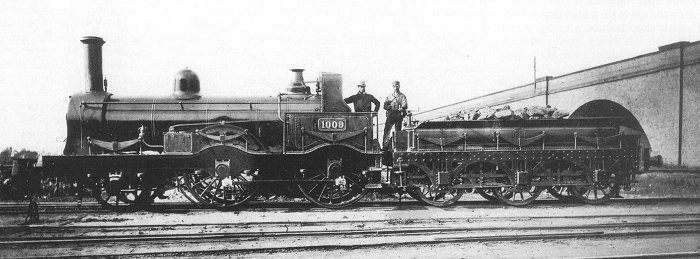
Another view showing the surviving
broad gauge lines in the lower shed yard in the same era
captures '111' class 2-4-0 No 1009. Quality views of
such early engines are invaluable, but the broad gauge
track is important too, as the only other location where
the broad gauge is to be seen in a photograph in the
Wolverhampton area is of mixed gauge from the OW&WR, at
Wolverhampton station circa 1855. It is a puzzle as to
why this track was retained at Stafford Road for such a
long time. As we will see, it would, however, be removed
and re-laid with standard gauge track by 1883. The
depicted standard gauge engine was from a class of
twenty (including two renewals) built at the Stafford
Road Works between 1863 and 1866 - they were also the
first class of 2-4-0s to be designed by Joseph
Armstrong. This photograph probably dates from the
mid-1870s, following the replacement of the original
1866 flat spectacle plate with a small Stafford
Road-type curved cab that afforded the footplate crew
marginally more protection from the elements; No 1009
would serve until January 1904. Author's Collection,
from an original by R. Bleasedale. |
|
In about 1890 the running shed that
had been built near to Oxley viaduct in 1858 was
demolished, and in its place a new long shed was erected
backing on to Fox's Lane, and with access from the
turntable of No 3 shed. In later years this shed
subsequently became the paint shop, and later became the
road motor workshop.
After the death of Sir Daniel Gooch
in 1889, the Directors of the GWR soon turned their
attention to the removal of the remaining broad gauge
system from the south of England, at which time the
important question arose as to which Works, Swindon or
Wolverhampton, ought to become the principal locomotive
building centre. Yet again, the ongoing problem of the
acquisition of enough land became the issue at
Wolverhampton.
The sandstone embankment, as
previously mentioned, also acted as a barrier between
the Works and the landowner's gardens and private
approach road to his house. As a consequence he could
not be persuaded to sell the land at a price that was
acceptable to the GWR, and unfortunately the end result
was that Swindon was chosen for development, instead of
Wolverhampton. |

A track plan of Stafford Road
Works and running sheds in 1875 helps to give a better
understanding of the lower shed yard (bottom left)
around the time of the two previous photographs, and it
also offers a excellent cross-reference to the next view
of the GWR-built facilities as seen from the L&NWR
viaduct (just in view at the extreme bottom left), which
was photographed once the broad gauge rails had finally
been removed. Authors Collection. |
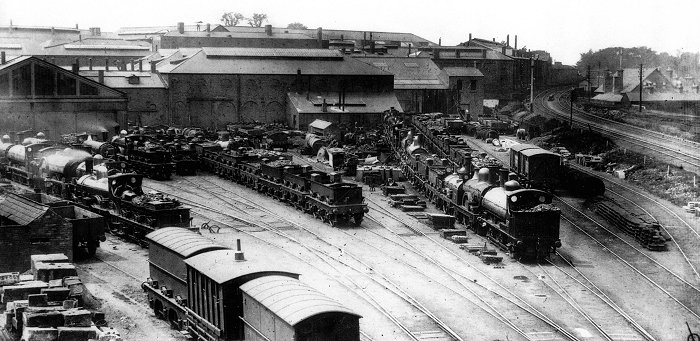
Stafford Road Works and shed yard,
as photographed circa 1883 from the L&NWR Stour Valley
Railway viaduct. It was almost certainly taken by R. H.
Bleasedale, whose remarkable railway photographs are
among the earliest that survive in any quantity. To the
extreme left is the corner edge of No 3 shed, built in
1860, and to its immediate right is a former broad-gauge
locomotive shed (at this time in use as a tender repair
shop) erected around 1857. This was one of the more
prominently sited of at least three broad-gauge sheds
that at one time served Stafford Road. In time this
building would again be a running shed, for
standard-gauge locomotives, and it would in fact still
be in use up until the shed's closure in 1963. An
earlier broad-gauge shed is also extant in this
photograph, it being situated to the far right-hand side
of the building complex, flanking the curved running
line that approaches Stafford Road Junction (out of
sight); at this time it was in use as a smithy, with a
forge to the rear. Dunstall Park station is yet to be
built - it wouldn't open until 1 December 1896, and
would be sited to the right-hand side of the photograph.
The large flat-fronted building at the centre of the
view is the old lower yard locomotive erecting shop.
Identifiable locomotives in the yard are believed to be
as follows. On the right-hand side, the row is headed up
by 0-6-0ST No 152, facing an ex-West Midland Railway
2-2-2, No 214 (Beyer, Peacock, 1861), and next to this
is ex-Shrewsbury & Chester Railway 2-2-2 No 14 (Sharp
Brothers, 1848). After its withdrawal in 1885, this
engine was preserved at Wolverhampton until an arbitrary
decision was made in 1920 to cut it up - a sad loss to
preservation. To the rear is a '322' class 0-6-0 (Beyer,
Peacock, circa 1845); the other locomotives in the line
are unknown. On the left-hand side is 2-4-0 No 725
(Swindon, 1872), to the rear are three '1501' class
0-6-0STs, and to the right of this line (facing the
camera) is a domeless boiler 2-2-2, either No 999 Sir
Alexander or No 1121 (Swindon, 1875) - Sir Alexander was
shedded at Wolverhampton for use on Paddington express
trains. Just visible to the right of these engines is
2-4-0 No 806 (Swindon, 1873), which regularly worked
Wolverhampton to Chester expresses. In the centre of the
scene is a row of six locomotive tenders awaiting
attention, and in the bottom left-hand corner are large
blocks of stone stored by the GWR bridge department,
adjacent to three Works vans, two of which are mounted
on old tender frames. It is believed that these were
used to house acetylene supplies, with take off points
from the tube surrounding the van body. Author's
Collection. |
| An extract from a 1880s' legal
plan of the complete Works area as it was at that time
(north is to the left), as used to note the acquisition
or subsequent disposition by the GWR of various parcels
of land.
The plan also illustrates the
location of the two-part bridge which crossed the canal,
with the tracks then running beneath the arches of the
L&NWR's Stour Valley Railway viaduct, providing both
main-line access and also a route into a separate
coaling stage area that was eventually rebuilt and
enlarged, circa 1900. Author's Collection. |
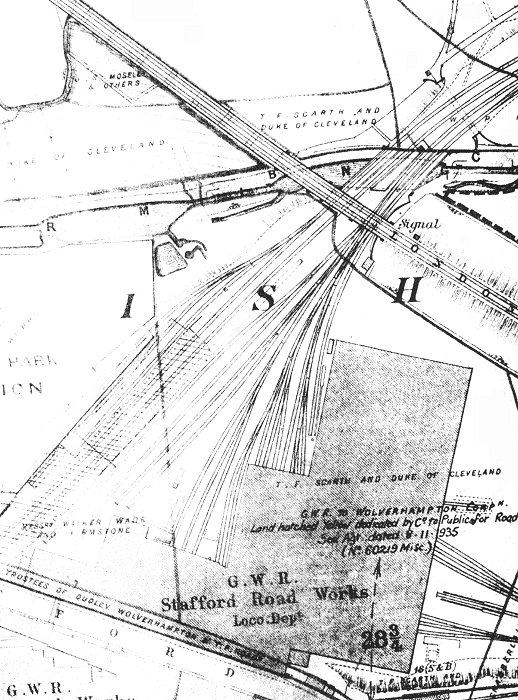 |
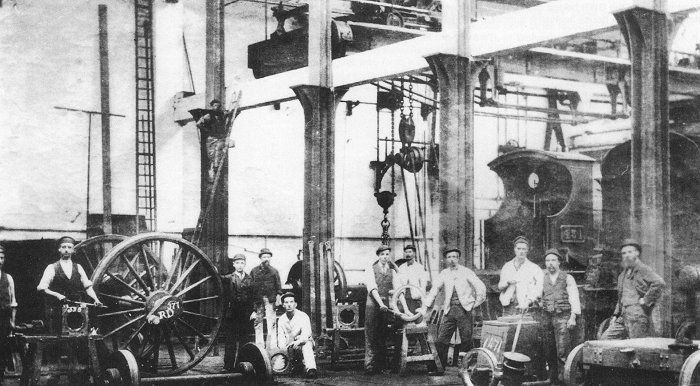
An 1890s' view of the lower yard
erecting shop at Stafford Road Works. On the left-hand
side an employee stands poised with a large file above
what appears to be an axlebox from a Beyer, Peacock & Co
Ltd 0-6-0. The adjacent set of 6ft driving wheels are
marked up as RD (right driver) 377. This engine was one
of the '111' class of 2-4-0s and it was rebuilt at
Stafford Road Works in April 1896 and so, as a
consequence, this gives a good indication as to the
actual date of the photograph. To the right can be seen
'Standard Goods' locomotive No 431 awaiting attention.
Courtesy of Simon Dewey. |
|
Notwithstanding the choice of
Swindon, Wolverhampton Locomotive Works continued to
maintain its independence until George Armstrong retired
in 1897. He was replaced by the Works Manager, W. H.
Waister, who only months later also went to Swindon to
become Locomotive Running Superintendent of the GWR. He
was in turn replaced at Wolverhampton by J.A. Robinson,
again in 1897, and at this period of time of managerial
uncertainty the authority was taken over by William Dean
at Swindon headquarters, who from then on continued to
maintain formal responsibility over the day-to-day
running of the Wolverhampton Works.
Around the turn of the century,
however, land values in the vicinity of the
Wolverhampton Works eventually began to fall as a result
of the spread of generalised industrialisation in the
town, with the additional effect that the housing for
the factory workers also continued to expand and
increase. It was at this time that the GWR was
eventually sold the extra land that it had wanted for
such a long time, and plans were drawn up for a major
expansion of the Works. Building contractors were
employed, and actually began to cut away at the
sandstone hill. The spoil excavated was then used to
build up the lower slopes down towards Gorsebrook Road,
to the rear, again with the effect of increasing the
area of land that could be made available for use.
The project was soon abandoned, as
unfortunately by this time Wolverhampton Works was found
to be incapable of handling the construction of the
increasingly large locomotives that were now required by
the Great Western. As a result, actual locomotive
construction finally ceased at Stafford Road Works in
1908, the last new locomotives being a batch of twenty
2-6-2Ts, which became Nos 4500-4519. As an aside, from
this class No 4510 was the only Stafford Road-built
engine to suffer bomb damage during World War II when an
early-morning workmen's train was straddled by bombs and
derailed on 12 January 1941 at Penryn, on the GWR's
Falmouth branch. No one was hurt, and the engine only
suffered minor damage as a result of the enemy action.
Since 1858, Wolverhampton's
Stafford Road Works had constructed a total of 794
locomotives, together with 102 rebuilds, which in
reality were so extensive as to be virtually new, and it
also produced six railmotor engines, apart from all of
the ongoing day-to-day Heavy repairs and locomotive
modifications. |
 |
|
 |
|
 |
Return to the exhibition
transport services hall |
|
Return to the museum
transport hall |
|
Proceed to
part 2 |
|